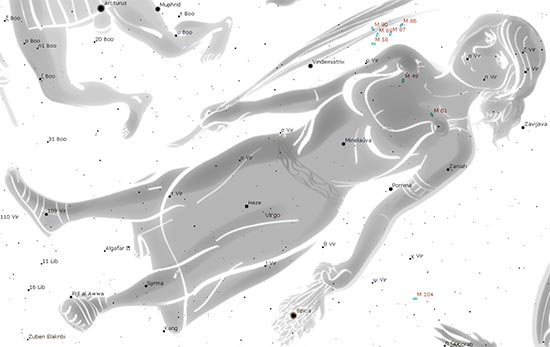Page 8


Spring Observing Targets - The Virgin Sky
By Tom Campbell
In mythology, the constellation of Virgo is sometimes identified as Ceres, the goddess of agriculture. It is also sometimes personified as Ceres' beautiful daughter, Proserpina.
The Legend
According to legend, Pluto (god of the Underworld) was driving his black chariot through the countryside and spotted Proserpina out in the fields playing with her friends. Pluto was drawn to her beauty and abducted her and took her with him to the Underworld.
Ceres was desperate to get her daughter back and neglected her agricultural duties. Soon, crops began to die and famine raged across the land. Jupiter decided to step in and told Pluto that he had to allow Proserpina to return to the land of the living for six months of every year. So, beginning in March, Virgo once again appears in the sky and crops begin to grow. However, in August, Pluto takes Virgo back with him to the Underworld and the crops begin to die out again.
Galaxies and Messier Objects
Virgo faces away from the plane of our Milky Way galaxy, so most of the celestial objects we find there are other galaxies. In fact, Virgo contains some of the richest areas for galaxy hunters, and if you like hunting Messier objects, Virgo has eleven of them to enjoy.
Spica
Virgo is usually depicted with an ear of corn in one hand and wearing flowing robes. The ear of corn is marked by the brightest star in the constellation, Spica (α Vir). Spica is the 16th brightest star in the night sky and is located about 250 light years from us. It is actually a spectroscopic binary system, with the primary being a blue giant. The two stars cannot be separated in a telescope and are, in fact, so close together that they are egg-shaped rather than spherical.

Virgo
Image from Stellarium Freeware Planetarium Software
Porrima
Porrima (γ Vir) is perhaps the most well-known double in Virgo and the easiest to find. Both stars are naked eye but so close together that they appear as a single star unless using a telescope. The stars take 169 years to complete one orbit around each other. From our perspective on Earth, this orbit sometimes puts them very near and at other times very far apart. Their closest point most recently occurred in 2005, so each year they will get a little easier to split.
I observed Porrima in 2001 when the two stars were getting closer together. Through my 8-inch Dobsonian, it required 305X to barely split the pair. Both components appeared equally bright and white in color.
17 Virginis
17 Virginis is another pretty double star. The primary star can barely be seen with the naked eye on a dark night. The main star appears pale yellow white and its companion is yellow-orange, making for a nice contrast.
Messier Galaxy Collection
Messier 49 is an elliptical galaxy near Virgo's right collar bone. With my 8-inch Dobsonian in rural skies, I was able to barely detect a stellar core and averted vision revealed a dim foreground star superimposed near the edge.
The other collar bone is defined by Messier 61. This face-on spiral galaxy is large, but somewhat faint. Under dark skies you might be able to detect hints of the spiral arms.
West of Vindematrix is a large collection of Messier galaxies situated along the Virgo-Coma Berenices border. Messier 58 is a nice example of a barred spiral galaxy. It is oriented almost face-on.
Messier 59 is an elliptical galaxy that is very elliptical in appearance.
Messier 60 is another elliptical galaxy, a bit brighter and larger than M 59. It also has a stellar core.
Right next to M 60 is NGC 4647. This face-on spiral galaxy appears much smaller and fainter than its companion, and its arm structure is very difficult to discern.
Messier 84 is an interesting spherical galaxy that has a large dust lane bisecting it. It is situated in the heavily populated inner core of the Virgo Cluster of Galaxies.
In the same field of view as M 84 is Messier 86. This galaxy is even more elliptical then M 84 and has an obvious stellar core.
Messier 87 is also known as the Smoking Gun galaxy, or Virgo A. It has a large jet that is believed to be emanating from a supermassive black hole in the center of the galaxy. Although difficult to see, this jet is visible at optical wavelengths as well as X-Rays. Can you detect it?
Messier 89 is an elliptical galaxy a little larger and brighter than nearby M 58. I was able to detect a small, bright stellar core in my 8-inch telescope and its shape appeared elliptical, although long-exposure photographs of the galaxy show it to be more nearly spherical.
Messier 90 is a large spiral galaxy. The galaxy is oriented at a moderate angle towards us, so that it appears more like an elliptical galaxy.
By pointing your telescope about halfway along a line from Porrima to Beta Corvi, you will come across Messier 104, the Sombrero Galaxy. This spiral galaxy is seen almost edge-on and has a large, dark dus lane bisecting it, which gives it the appearance of a large hat on someone’s head.
Another way to find this galaxy is to aim at Gamma Corvi. At low power, there is a chain of bright stars each about a field of view apart that leads to a Sagitta-shaped asterism of fainter stars that point right to the galaxy.
In my 8-inch telescope the dust lane is very noticeable, but if seeing isn't good, the galactic core "below" the dust lane can disappear, giving the galaxy more of a UFO shape.
Caldwell 52
With all the galaxies visible in this constellation, you might be surprised to learn that there's only one Caldwell object in Virgo. Caldwell 52 is an elliptical galaxy located about 4.5 degrees southeast of Porrima.
Quasar 3C 273
Our final object on this tour of Virgo is one of the most distant objects in the universe that's within reach of a modest-sized amateur telescope. 3C 273 is a quasar located over 2.4 billion light years away. A quasar is a powerful jet of material ejected from a supermassive black hole at the center of a distant galaxy.
In a visual telescope, a quasar appears as nothing more than a point of light, just like a star. In fact, the name quasar is actually an acronym for "QUAsi-StellAr Radio source." Yes, it's a terrible acronym, but astronomers aren't known for being very creative with names.
Since 3C 273 will look just like any other dim star, it will be difficult to know when you've actually found it in the eyepiece. Printing out a good star chart of the area will help immensely.
Image credit in top banner: Sidney Hall [Public domain], via Wikimedia Commons
| Object | Type | Mag(s) | Dist. (ly) | R. A. | Dec. |
|---|---|---|---|---|---|
| α Vir (Spica) | Star | 1.0 | 250 | 13h 25.2m | -11° 10' |
| γ Vir (Porrima) | Double star | 3.6, 3.6 | 38 | 12h 41.7m | -01° 27' |
| 17 Vir | Double star | 6.5 | 97 | 12h 23.5m | +05° 12' |
| M 49 | Galaxy (E2) | 8.3 | 57,737,000 | 12h 30.6m | +07° 54' |
| M 58 | Galaxy (SAB) | 9.7 | 62,304,000 | 12h 38.6m | +11° 43' |
| M 59 | Galaxy (E5) | 10.6 | 59,695,000 | 12h 43.0m | +11° 33' |
| M 60 | Galaxy (E2) | 9.8 | 54,802,000 | 12h 44.6m | +11° 27' |
| NGC 4647 | Galaxy (SAB) | 12.5 | 79,919,000 | 12h 44.5m | +11° 29' |
| M 61 (Swelling Spiral) | Galaxy (SAB) | 9.7 | 52,518,000 | 12h 22.9m | +04° 22' |
| M 84 | Galaxy (E1) | 10.5 | 60,021,000 | 12h 26.0m | +12° 47' |
| M 86 | Galaxy (S0) | 8.9 | 51,866,000 | 12h 27.1m | +12° 51' |
| M 87 (Smoking Gun) | Galaxy (Pec) | 8.6 | 60,021,000 | 12h 31.7m | +12° 17' |
| M 89 | Galaxy (E) | 9.8 | 50,006,000 | 12h 36.6m | +12° 27' |
| M 90 | Galaxy (SAB) | 9.5 | 58,716,000 | 12h 37.8m | +13° 04' |
| M 104 (Sombrero) | Galaxy (SA) | 8.0 | 29,293,000 | 12h 40.9m | -11° 43' |
| C 52 | Galaxy (E6) | 11.0 | 40,514,000 | 12h 49.6m | -05° 54' |
| 3C 273 | Quasar | 12.9 | 2,443,000,000 | 12h 29.1m | +02° 03' |
